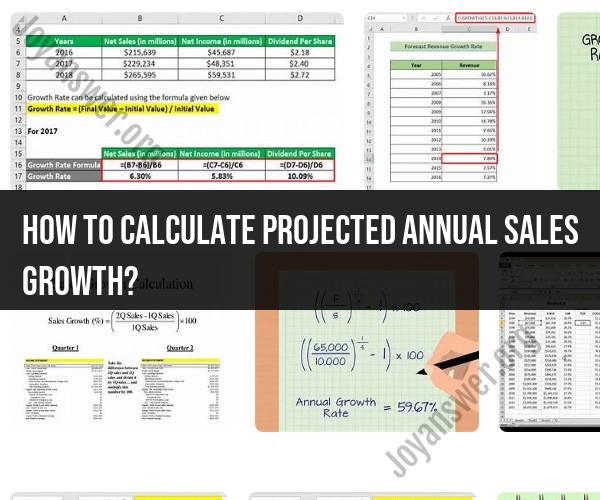How to calculate projected annual sales growth?
Projected annual sales growth is an important metric in financial forecasting. It helps businesses estimate how their revenue is expected to increase or decrease over a specified time period. To calculate projected annual sales growth, you can use the following formula:
Projected Annual Sales Growth (%) = [(Project Year Sales - Base Year Sales) / Base Year Sales] x 100
Here's a step-by-step guide on how to use this formula:
Select a Base Year: Determine the base year for your analysis. This is the starting point from which you want to measure sales growth. Typically, businesses use the most recent complete fiscal year as the base year.
Choose a Project Year: Select the year for which you want to project sales growth. This can be a future year you're planning for or any year you want to analyze.
Calculate Sales for the Base Year: Find the total sales revenue for the base year. This figure should include all sources of revenue, such as product sales, services, and any other income generated by the business.
Calculate Sales for the Project Year: Determine the projected or expected sales revenue for the project year. This can be based on your business's sales projections, market analysis, historical growth rates, and other relevant data.
Apply the Formula: Use the formula mentioned above to calculate the projected annual sales growth percentage. Subtract the base year sales from the project year sales, divide the result by the base year sales, and then multiply by 100 to express the growth as a percentage.
For example, if your business had $1,000,000 in sales in the base year and you project $1,200,000 in sales for the project year, the calculation would be as follows:
Projected Annual Sales Growth (%) = [($1,200,000 - $1,000,000) / $1,000,000] x 100 = (0.2 / 1) x 100 = 20%
In this example, the projected annual sales growth is 20%, indicating that sales are expected to increase by 20% from the base year to the project year.
It's essential to remember that projected annual sales growth is a simplified estimation. In real-world scenarios, you should consider other factors like market conditions, industry trends, competition, and internal factors that may impact your sales growth. This formula provides a basic framework for calculating sales growth, but it should be part of a comprehensive financial forecasting process.
Calculating Projected Annual Sales Growth: Strategies for Success
To calculate projected annual sales growth, you can use the following formula:
Projected sales growth = (Projected sales for next year - Current year's sales) / Current year's sales * 100%
For example, if your company's current year sales are $1 million and you project sales to be $1.2 million next year, your projected annual sales growth would be 20%.
Here are some tips for calculating projected annual sales growth successfully:
- Use historical sales data to identify trends and patterns.
- Consider factors such as market trends, new product launches, and competitor activity.
- Be realistic and conservative in your projections.
- Review your projections regularly and update them as needed.
Using Data and Insights to Forecast Sales Growth
There are a number of ways to use data and insights to forecast sales growth. Some common methods include:
- Time series analysis: This involves analyzing historical sales data to identify trends and patterns.
- Causal analysis: This involves identifying factors that are likely to impact sales growth, such as market trends, new product launches, and competitor activity.
- Judgmental forecasting: This involves using expert judgment to forecast sales growth.
By using a combination of these methods, you can develop a more accurate forecast of sales growth.
The Role of Projections in Business Planning
Sales projections play an important role in business planning. They can help you to:
- Set goals and objectives
- Make informed decisions about resource allocation
- Identify potential risks and opportunities
- Track your progress over time
By having accurate sales projections, you can better position your business for success.
Real-Life Examples of Successful Sales Growth Predictions
Here are a few real-life examples of successful sales growth predictions:
- Amazon: Amazon has been consistently successful in forecasting sales growth. In 2021, Amazon projected sales growth of 24-33%. The company's actual sales growth for the year was 22%.
- Tesla: Tesla has also been successful in forecasting sales growth. In 2021, Tesla projected sales growth of 50%. The company's actual sales growth for the year was 87%.
- Apple: Apple is another company that has been successful in forecasting sales growth. In 2021, Apple projected sales growth of 24-28%. The company's actual sales growth for the year was 25%.
These examples show that it is possible to forecast sales growth accurately. By using data and insights, you can develop sales projections that will help you to make informed decisions about your business.
Personal Tips and Perspectives on Sales Projections
Here are a few personal tips and perspectives on sales projections:
- Be realistic and conservative in your projections. It is better to underestimate sales growth than to overestimate it.
- Review your projections regularly and update them as needed. The business landscape can change quickly, so it is important to have up-to-date sales projections.
- Use a combination of forecasting methods. This will help you to develop a more accurate forecast.
- Don't be afraid to ask for help from experts. There are a number of resources available to help you with sales forecasting.
Sales projections are an important tool for businesses of all sizes. By using data and insights, you can develop sales projections that will help you to make informed decisions about your business and achieve your goals.













